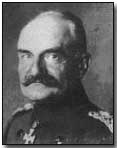Who's Who - Fritz von Below
 Fritz Wilhelm Theodor Karl von Below
(1853-1918) was a cousin of
Otto von Below
(reported variously as his brother),
both of whom served in command positions in the German army during World War
One.
Fritz Wilhelm Theodor Karl von Below
(1853-1918) was a cousin of
Otto von Below
(reported variously as his brother),
both of whom served in command positions in the German army during World War
One.
Fritz von Below's achievements were in fact overshadowed by the flashier success of Otto's, particularly once Otto's success at Caporetto became widely known.
Nevertheless, Fritz von Below was himself a competent rather than spectacular military commander who gained prominence while commanding XXI Corps at the Second Battle of the Masurian Lakes in February 1915 while serving on the Eastern Front.
Following this action Below was handed a promotion, when given command of Second Army, this time operating on the Western Front, where he replaced Karl von Bulow.
Under strength with just three divisions while occupying an area of land from Noyon to Gommecourt, Below was faced with the British Somme Offensive in July 1916 which, warned German Chief of Staff Erich Falkenhayn, was likely to be launched to provide relief to the French, at that time struggling at Verdun.
Falkenhayn was however by no means convinced that the British offensive was likely to be positioned against Below's forces, despite Below's own mounting conviction that such was the case (an impression gained largely from aerial reconnaissance). Rather, Falkenhayn anticipated an attack at Arras; consequently he provided Below with little in the way of reinforcements.
Below, clear in his own mind that an attack was imminent, prepared as best he could, instructing his troops to dig a series of virtually impregnable dugouts to protect his men from the coming artillery storm. Below's hunch proved correct, and despite the fierce British artillery bombardment launched in the week prior to their infantry assault on 1 July 1916, the German defences remained largely unaffected.
This proved crucial in enabling Below's defenders to quickly resurface from their deep hideouts once the British artillery bombardment ceased, and to then man the prepared machine gun positions with deadly efficiency. The first day of the Battle of the Somme established itself as the most costly single day of battle in British history, with nearly 60,000 casualties suffered on the first day alone.
For all that, Falkenhayn was not convinced that Below had successfully defended his position following the British attack, particularly given the success of a French advance into the German second line at nearby Peronne.
Falkenhayn chose to replace Below's Chief of Staff, General Grunert, as punishment for the apparent German retirement at Peronne; Falkenhayn further commanded that any lost ground be immediately retaken. This resulted in numerous German counter-attacks at the Somme at tremendous loss to the German attackers.
In mid-July Falkenhayn, still unhappy, redeployed von Below to command the new First Army sited south of the Somme, where, in April 1917, Below was responsible for managing the German defence against the disastrous French Nivelle Offensive.
Below served out the remainder of the war in overseeing the preparation of a new German army manual, written for the infantry, which took into consideration the German experience of war since 1914.
Fritz von Below, who died in 1918, was awarded Germany's prestigious Pour le Merite on 16 February 1915 for his efforts on both Eastern and Western Fronts (most notably at the Second Battle of the Masurian Lakes). His award was supplemented by the Oakleaves on 11 August 1916 in recognition of his efforts on the Somme.
"Wipers" was the British nickname for the Belgian town Ypres.
- Did you know?
